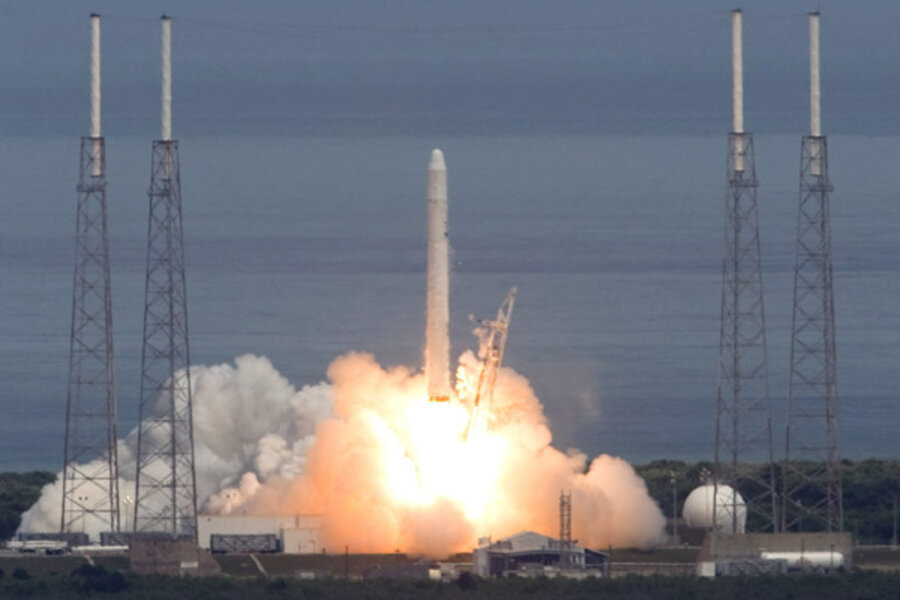Falcon 9 launch takes place after aborted attempt
Loading...
The brand new commercial Falcon 9 rocket soared into orbit from Florida on its maiden flight Friday, the first test for a new era of private vehicles that could one day send cargo – and possibly astronauts – into space.
The Falcon 9 rocket, built by private company Space Exploration Technologies (SpaceX), blasted off at 2:45 p.m. EDT (1845 GMT) from its seaside launch pad at Cape Canaveral Air Force Station in Florida.
"It's been a good day for SpaceX," said SpaceX launch commentator Robyn Ringuette.
IN PICTURES: NASA's Future of Space Exploration
An earlier launch attempt today at 1:30 p.m. EDT (1730 GMT) was aborted when a last minute glitch caused SpaceX to halt just after ignition of the rocket's engines. The issue was an "out-of-limit startup parameter," according to Ringuette.
Before that, the launch was delayed past an initial 11 a.m. EDT (1500 GMT) target time a blocked signal from the rocket's telemetry system, which enables the launch team to track the vehicle from afar.
After that issue was resolved, a report came from the U.S. Air Force that a boat had strayed into the safety range on the Atlantic Ocean over which the Falcon 9 rocket would fly during its trip to space. The launch had to wait until the boat was cleared before proceeding.
Finally, SpaceX recycled the launch countdown and succeeded launching on its second try, when all systems appeared to function as designed for a smooth first blastoff of the untried rocket.
"It's a huge milestone achievement for SpaceX as a company, because they've invested a lot of time, a lot of money, a lot of engineering, and to get to an actual flight test is definitely an impressive achievement," said Brett Alexander, president of the Commercial Spaceflight Federation, a private industry group.
The Falcon 9 vehicle already has a $1.6 billion contract with NASA to haul cargo to the International Space Station, and may one day carry astronauts as well. Today's successful launch adds fuel to the hopes that the rocket will be the first non-government spaceship to carry people to orbit.
The 178-foot (54-meter) tall liquid-fueled booster flew a mockup of the Hawthorne, Calif.-based company's Dragon capsule, which is planned to carry cargo, and eventually crew, to space.
This SPACE.com graphic shows how the Falcon 9 rocket compares with NASA's shuttles and other spacecraft.
Falcon 9 traveled eastward off the pad to orbit about 155 miles (250 km) above Earth. SpaceX hopes to recover the first stage of the rocket, which fell into the Atlantic Ocean after launch and was buoyed by parachutes on its descent.
Today's successful test launch likely means that the next time the rocket blasts off, it will head straight to the space station to practice delivering supplies. An actual docking and cargo delivery would probably take place on the Falcon 9's third flight, SpaceX has said.
This successful trial flight will likely provide a boon to President Barack Obama's plan to shift responsibility for ferrying astronauts to the International Space Station to the commercial space sector after the space shuttles retire this year. The President proposed cancelling NASA's existing Constellation plan to build a shuttle replacement.
"If [the test launch] is successful I think it's symbolically the new age, because it's the first time to orbit by a vehicle being built entirely by a private corporation," space policy expert Roger Handberg, a political scientist at the University of Central Florida, said before the flight. "It is a game changer in that sense. It makes the commercial space stuff finally credible."
The launch could help ease doubts of some lawmakers that private space companies are up to the task.
"What people have been saying in Congress is the commercial sector can't do it," Handberg told SPACE.com. "I think in the larger congressional community there will be less willingness to say, 'Oh yeah, we need to keep the shuttle flying, keep Constellation going.' I think they'll be more willing to back the President."
But some doubt that skeptics will be persuaded by the successful launch.
"If it's a success I don't expect critics of the administration's plan to say anything positive," Alexander said on Thursday. "They'll just say, 'It's only a test.'"
While the achievement is significant for SpaceX, he said, the whole future of the commercial space industry is not riding on the success or failure of this one trial. SpaceX itself agreed.
"Tomorrow's launch should not be a verdict on the viability of commercial space," Musk said Thursday. "Commercial space is the only way forward," he said, because of the limited budget of governmental space programs.
Ultimately, SpaceX plans to reuse most elements of their spacecraft to cut down costs and make space affordable for more civilians to travel beyond Earth.
"Unless we can make dramatic improvements to the cost and reliability of space transport and make it closer to air transport, it will only ever be a small number of launches that take place every year at extreme expense," Musk said.
- 6 Private Companies That Could Launch Humans Into Space
- Top 10 Fantasy Spaceships Becoming Reality
- Gallery: SpaceX's Falcon 9 Rocket Photos
Click here for SPACE.com's live coverage of SpaceX's Falcon 9 rocket test flight.
IN PICTURES: NASA's Future of Space Exploration


